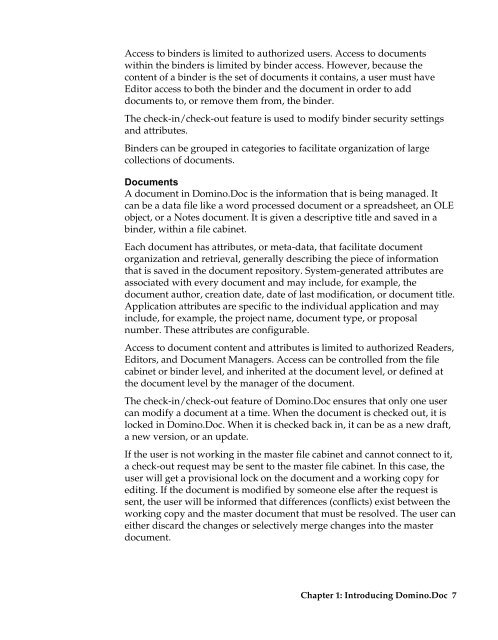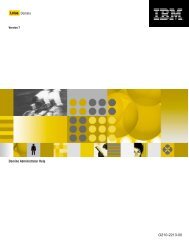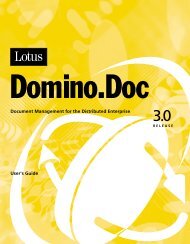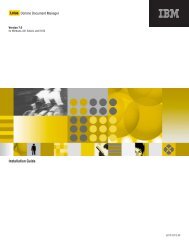Domino.Doc 3.5 User's Guide - Lotus documentation - Lotus software
Domino.Doc 3.5 User's Guide - Lotus documentation - Lotus software
Domino.Doc 3.5 User's Guide - Lotus documentation - Lotus software
Create successful ePaper yourself
Turn your PDF publications into a flip-book with our unique Google optimized e-Paper software.
Access to binders is limited to authorized users. Access to documents<br />
within the binders is limited by binder access. However, because the<br />
content of a binder is the set of documents it contains, a user must have<br />
Editor access to both the binder and the document in order to add<br />
documents to, or remove them from, the binder.<br />
The check-in/check-out feature is used to modify binder security settings<br />
and attributes.<br />
Binders can be grouped in categories to facilitate organization of large<br />
collections of documents.<br />
<strong>Doc</strong>uments<br />
A document in <strong>Domino</strong>.<strong>Doc</strong> is the information that is being managed. It<br />
can be a data file like a word processed document or a spreadsheet, an OLE<br />
object, or a Notes document. It is given a descriptive title and saved in a<br />
binder, within a file cabinet.<br />
Each document has attributes, or meta-data, that facilitate document<br />
organization and retrieval, generally describing the piece of information<br />
that is saved in the document repository. System-generated attributes are<br />
associated with every document and may include, for example, the<br />
document author, creation date, date of last modification, or document title.<br />
Application attributes are specific to the individual application and may<br />
include, for example, the project name, document type, or proposal<br />
number. These attributes are configurable.<br />
Access to document content and attributes is limited to authorized Readers,<br />
Editors, and <strong>Doc</strong>ument Managers. Access can be controlled from the file<br />
cabinet or binder level, and inherited at the document level, or defined at<br />
the document level by the manager of the document.<br />
The check-in/check-out feature of <strong>Domino</strong>.<strong>Doc</strong> ensures that only one user<br />
can modify a document at a time. When the document is checked out, it is<br />
locked in <strong>Domino</strong>.<strong>Doc</strong>. When it is checked back in, it can be as a new draft,<br />
a new version, or an update.<br />
If the user is not working in the master file cabinet and cannot connect to it,<br />
a check-out request may be sent to the master file cabinet. In this case, the<br />
user will get a provisional lock on the document and a working copy for<br />
editing. If the document is modified by someone else after the request is<br />
sent, the user will be informed that differences (conflicts) exist between the<br />
working copy and the master document that must be resolved. The user can<br />
either discard the changes or selectively merge changes into the master<br />
document.<br />
Chapter 1: Introducing <strong>Domino</strong>.<strong>Doc</strong> 7












